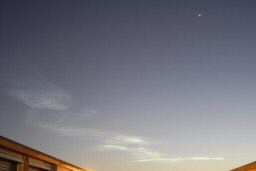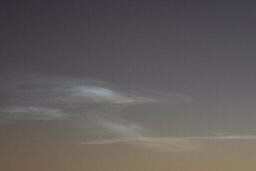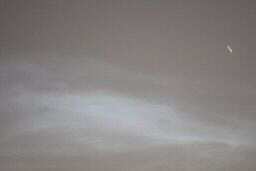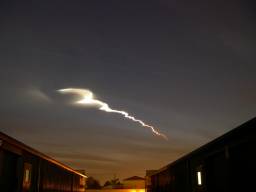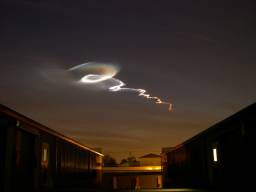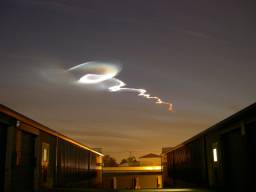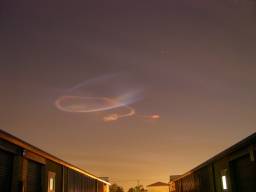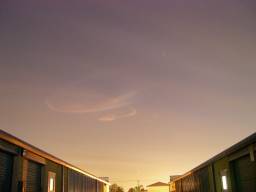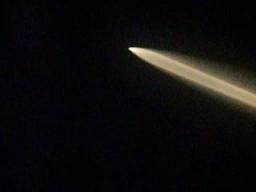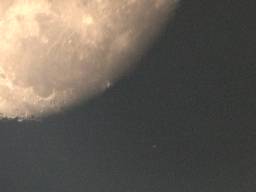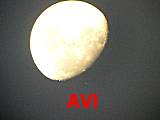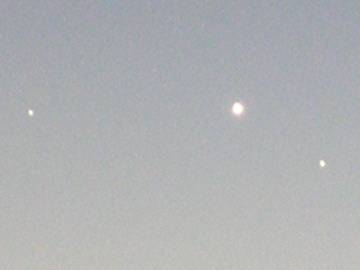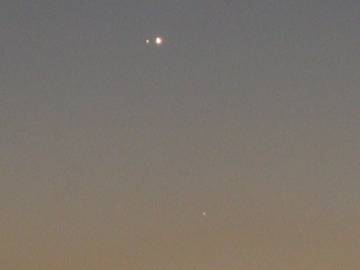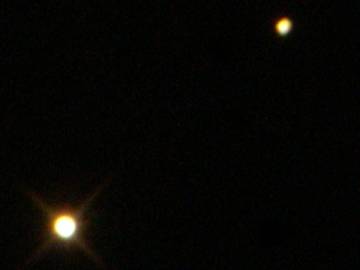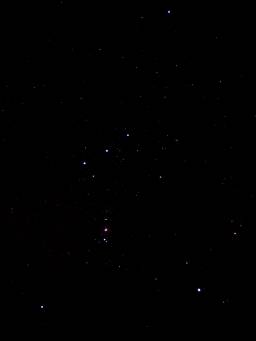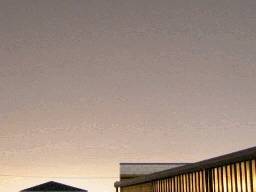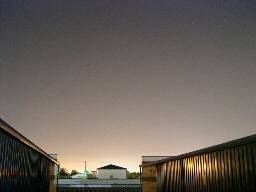
 |
 |
 |
 |
 |
 |
| Delta II Launches WISE - Widefield Infrared Survey Explorer On the morning of December 14th, 2009, a Boeing Delta II rocket launched NASA's Widefield Infrared Survey Explorer satellite into polar orbit. The launch was a morning twilight event and allowed the later stages of the exhaust plume to be lit by the rising sun, which was behind me from my viewing direction of the launch in north Orange County, CA. Although Vandenberg AFB is WNW (about 300º) from my location, the rocket did not become visible until it had passed due west. These pictures were taken about WSW. The apparent motion of the rocket was nearly horizontal at this point. All images were taken with a Nikon D200 camera and only reduced in size. Clicking on a thumbnail will bring up a larger picture. The final image was of the very thin waning Moon behind me towards sunrise. Thanks go to Brian Webb and his Space Archive website which provide email alerts for such opportunities. |
|
This rocket launched the COSMIC satellites into a polar orbit. The launch window was from 5:10pm to 8:10pm local time.
|
I
did not expect to see the launch due to a storm system moving through,
nor did I expect the launch to actually occur for the same reason. As it happened, it did go off. I caught these pictures of the exhaust trail while out shopping at around 8pm local time. The pictures are shaky as they were 4 second exposures and hand held. |
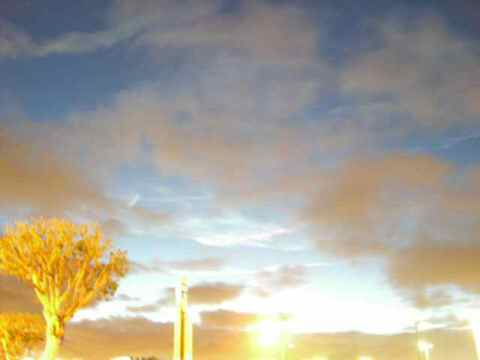 |
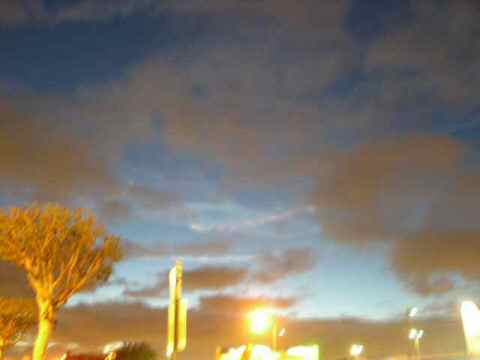 |
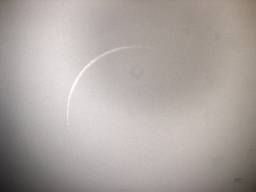 |
This is
an image of the
very new moon on October 4th, 2005. It's only 39 hours and 22 minutes
'new'. It was taken with a Nikon Coolpix 4300 and eyepice projection on
a 6" f/5 Newtonian using a 40mm eyepiece. It was very low to the
horizon, only 5 degrees or so. I lost it behind some trees just minutes
after this picture. The histogram and gamma was adjusted which really
brought out the vignetting and central obscuration of the secondary
mirror.
Click on the image to see an 800x600 reduction of the original resolution image. (48,509 bytes) |
| Minotaur
Launches STREAK Satellite from Vandenberg AFB On the
evening of
September 22, 2005, a Minotaur rocket launched from Vandenberg AFB
carrying the STREAK satellite for the US military. The Minotaur rocket
uses solid propellant and therefore leaves behind quite an exhaust
trail. Since this launch occured about 45 minutes after local sunset
that meant the sky view was deep twilight with the rocket rising into
the setting sun. The backlit and rapidly expanding plume is quite
spectacular. It's been about 3 years since the last launch from VAFB
provided the southwest US with such a spectacular sight.
For this launch I decided to try to get some video with my digital camera attached to my telescope. I was pretty successful. The tracking is not smooth as I was hand guiding through the spotting scope. Also, the view is off center as the spotting scope was apparently out of alignment a bit. None the less, the video is spectacular. The camera can only take 40 seconds of video so cuts off just after first stage burnout. Too bad as the second stage ignition was just stunning. After taking video I took the camera off the scope and mounted it on a tripod to take time exposure stills of the colorful dissipating plume. All images were taken with a Nikon Coolpix 4300. Viewing location was Stanton, north Orange County, CA. Click on a thumbnaill to download the larger image or QT video.
|
Sunspot
798 - 23:26 UT September 13, 2005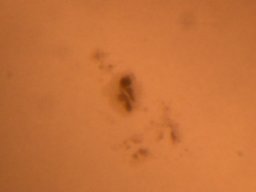 This
is a new image of sunspot 798 with much improved resolution. Unlike the
image below, it is not a stack and has not been processed except to
crop it down to 1024x768. This
is a new image of sunspot 798 with much improved resolution. Unlike the
image below, it is not a stack and has not been processed except to
crop it down to 1024x768.For this image I adjusted my makeshift solar filter to let in twice as much light as before, but stopped down the aperture to about 1". Since there was so much more light coming through now I was able to set the digital camera to take a 1/1000 second exposure with a higher f/ratio than before. This greatly increased the resolution of the image by reducing atmospheric turbulence effects. The eyepiece projection was also at a higher magnification than the image below. Click on the image to see a 1024x768 crop of the original resolution image. (79,771 bytes) |
Sunspot
798 - 20:00 UT September 11, 2005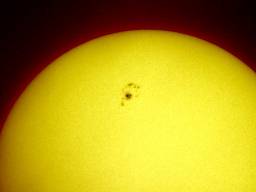 Sunspot
798 originally formed in late August and quickly became active.
However, it was rapidly approaching the limb of the Sun and soon
disappeared. Holographic helioseismology images indicated that this
sunspot continued to remain large while it traversed the far side of
the Sun and came back around again as sunspot 808. On September 7 while
on the Sun's left limb it emitted an X17 flare, one of the brightest
flares ever recorded. Fortunately because the sunspot was on the Sun's
limb, the energy of the flare was directed away from Earth. However,
this sunspot is slowly rotating across the Sun and will soon point
towards Earth and we could experience severe geomagnetic storms with
magnificent aurora. Sunspot
798 originally formed in late August and quickly became active.
However, it was rapidly approaching the limb of the Sun and soon
disappeared. Holographic helioseismology images indicated that this
sunspot continued to remain large while it traversed the far side of
the Sun and came back around again as sunspot 808. On September 7 while
on the Sun's left limb it emitted an X17 flare, one of the brightest
flares ever recorded. Fortunately because the sunspot was on the Sun's
limb, the energy of the flare was directed away from Earth. However,
this sunspot is slowly rotating across the Sun and will soon point
towards Earth and we could experience severe geomagnetic storms with
magnificent aurora.The image at left is a stack of six 1/125th second images taken through my 6" Newtonian telescope with a makeshift solar filter and aperture stop using eyepiece projection into my Nikon Coolpix 4300 camera. Histogram and gamma adjustments were made to bring out the details. Click on the image to see a 1600x1200 crop of the original resolution image. (281,379 bytes) |
|
| Mercury/Venus/Saturn
Conjunction - June 24 & 27, 2005 On the
evening of July 24, 2005 the planets Mercury, Venus, and
Saturn were within 5 degrees of each other on the western horizon just
after sunset. This is about the diameter of your thumb held out at arms
length. Since they were so low in the sky there was only about 30-60
minutes time to view this celestial gathering. Too early and they were
washed out by the evening twilight. Too late and they were below the
horizon.
|
Iridium
80 Flares Across The Moon - November 17, 2004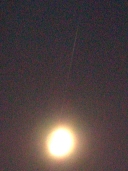
Using
the Heavens Above
web site, I found had an estimated 0 magnitude flare for Iridium 80
this evening, I plugged the coordinates of the estimated maximum flare
position into my planetarium program to see where it would be in
reference to the crescent moon. Seeing that the flare was only a few
moon diameters away, I plugged in the latest TLE's for Ir80 into some
sat tracking software and found that the track might take it very close
to, if not directly over the moon!! I had plenty of time to set up and
take some test exposures to try to find the right balance of not over
exposing the moon and trying to catch the flare. Since I had to do
contrast and brightness enhancement to the image I now realize I should
have just gone for maximum exposure settings. Even so, the picture came
out great. The satellites track brought it across the dark side of the moon.
Just click on the thumbnail to the left to see a 1024x768 jpeg (691,699
bytes). Specs are on the image.
|
| X43A
Vapor Trail At Sunset November 16, 2004 NASA
successfully flew the
X43 SCRAMJet today to a speed of Mach 10. Although the flight
was
before 3pm PST, the vapor trail resulting from the Pegasus solid
booster had not fully dissipated by sunset a couple hours later. The
sunset was beautiful in it's own right, but seeing the vapor trail from
the X43 test just added to the value of the scene. In the picture
below, the vapor is the lighter colored wisps just above the power
lines. The launch was over the Pacific Ocean
west of the Los Angeles Area. The picture was taken in North Orange
County. To see the original full res version
right from the camera, click on the image. (196,832 bytes)
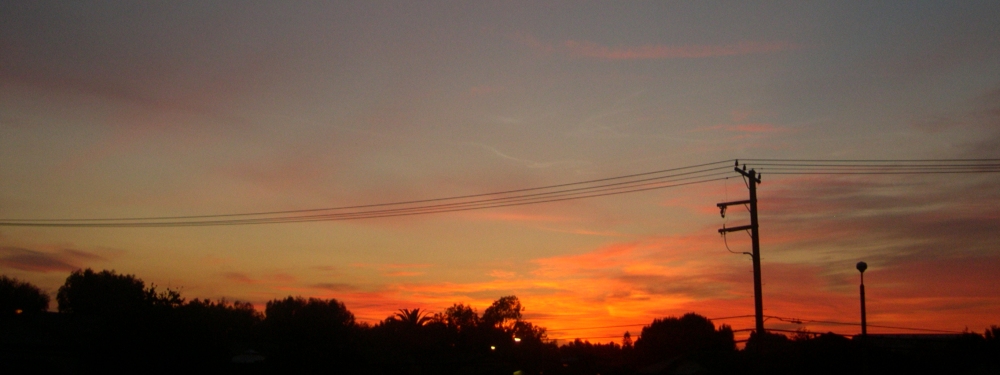 |
| Venus
Jupiter Conjunction November 4, 2004 - Daylight Images Venus
and Jupiter were
just 0.6 degrees apart at 12:41 PDT (2041UT) today. Since I was too
lazy to try to get up before dawn to see the pair in the night sky, I
decided to go for a harder challenge, observing the pair in daylight! I
have observed Venus and Saturn in the daytime. Saturn was easy as it
was being occulted by the Moon. Venus can be seen by the naked eye if
one knows where to look and can trick their eyes into focusing at
infinity when staring at a blank sky.
Anyway, I managed to find Venus at low power in my telescope and after a while I noticed Jupiter not far away, very faint. I decided to try for some pictures. Although I was certain I had captured Venus, I wasn't too hopeful of catching Jupiter. The contrast was very low. But once I downloaded the images from my camera into the computer I was pleasantly surprised to see that I had indeed managed to capture both planets in the same frame. Following are four frames that have been enhanced in contrast and brightness to bring out the pair. I also have a GIF animation of these four frames. 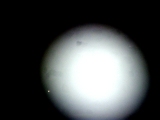 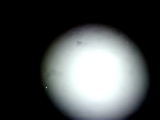 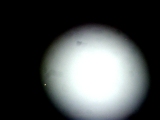 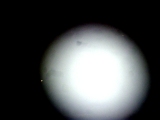 Animated GIF of the above four frames. The
images were severly vignetted already due to eyepiece projection, and
the enhancement process brought that out even more. The
telescope setup is a Meade 6600 6" f/5 newtonian with a 40mm eyepiece
projecting into a Nikon Coolpix 4300.
|
| Total
lunar eclipse October 27/28, 2004 I was
very fortuitous to
have been able to view this eclipse. The weather had been pretty wet
the past few days and just hours before the eclipse began a
thunderstorm had gone by. Well, Murphy must have been napping as the
weather cleared and the skies were magnificent in time to see
the eclipse. From my location in Southern California, the Moon was
already partially into the eclipse as the it rose above the horizon and
was clearly visible throughout the event. Clouds rolled in just as the
last of the penumbra was leavin the Moon. What luck!!!
This was also an opportunity to use try my new Nikon Coolpix 4300 out on my telescope using eyepiece projection. I used a 6" f/5 newtonian with a 40mm eyepiece resulting in an effective focal length of 459 mm at f/3. I took close to a hundred images but chose these few as the best. Just click on a thumbnail to bring up a 1024x768 jpg. Each image is imprinted with the time and exposure settings. |
| Constellation
Of Orion I've
been an amateur
astronomer ever since I was a kid, but I never got bitten by the
astrophoto bug, till now. These photos were taken with a Nikon Coolpix
4300 Digital camera piggybacked on my 6" Newt. I don't have a clock
drive so I hand guided the exposures while viewing M42 at 200 power,
concentrating on the Trapezium. With finesse I was managed to guide the
scope in RA smooth enough by hand that I stayed within the Trapezium.
Since the camera wasn't at high magnification even zoomed in, this was
more than sufficient to keep the images from trailing.
This camera has an CYMG sensor instead of the usual RGB. Image size was set to the maximum of 2272 x 1704 and format to minimally compressed jpeg. The camera is capable of saving images in raw TIFF format with no compression. Image processing was done using Paint Shop Pro version 7.04.
|
|
At 1:01 AM Pacific Time on the morning of September 15, 2004 a United States Air Force Minuteman III missile with three dummy warheads was launched on a test flight from Vandenberg Air Force Base on a 4200 mile, 30 minute flight to the Kwajalein Missile Range in the South Pacific. I used a Nikon Coolpix 4300 camera to take a series of high resolution 8 second exposures. The original images are 2272x1704 in size. For space and DL speed considerations I reduced the image sizes for the animation and still below.
I observed this launch from Stanton, California, approximately 140 miles ESE of the launch site at approximately 33.8N 118.0W. I have observed missile and rocket launches before but this is the first time I was able to take such good pictures. I had the camera all set up on a tripod ready to go as well as my telescope nearby. As I anxiously watched my watch 1:01 AM came and went. I knew it would take nearly another minute or more for me to see the rocket due to my distance from the launch site (Earth curvature) and for the rocket to rise above the haze and humidity on the horizon. As soon as I saw the vehicle I started the camera and stepped over to the scope. Through the scope I observed the rocket exhaust at 31x as a bright yellow spot followed by short orangish fuzzy cone. The rocket moved slowly making hand tracking a breeze. It was so easy I decided to try bumping up to my best eyepiece for a mag of 200x, but that was too much and I couldn't even find the rocket. I quickly switched back to 31x. Next time I'll try using my barlow for 62x, which shouldn't be too hard. I followed the rocket for a little more than a minute until burnout. About halfway through I observed what appeared to be a staging event; a brief dimming with a dim red light falling away from the rocket followed a few seconds later by a return to the previous brightness. After burnout I saw one brief flash of dim red light which was probably the spent booster tumbling away from the warhead package. Special thanks to Brian Webb and his Vandenberg Launch Schedule and Launch Alerts which can be found at http://www.spacearchive.info/ |
Favorite
Links      
Astronomy Picture of the Day - Just like it sounds. Heavens Above - Online satellite viewing predictions. Iridium flares are awesome to watch! Florida Today - Space - Florida Today newspaper section on space. Space.com - More space related news. Near Earth Asteroid Rendezvous Mission - The NEAR mission is over but the pictures are still there! THEMIS: Latest Images - Pictures from the Thermal Emission Imaging System on the Mars Odyssey spacecraft. Plot of the Inner Solar System - Shows the location of every known object int he Solar System. Space Archive - This is where I get information on launches from Vandenberg AFB. HEASARC Picture Of the Week - High Energy Astrophysics Science Archive Research Center. FMO home page - Fast Moving Object search. Seeking asteroids before they hit Earth. Mars Tour - View images from the Mars rovers! Cassini-Huygens Home - Home page for the Cassini mission to Saturn. Images of Saturn and All Available Satellites - Quick link to all Saturn images at JPL. Images of Mars and All Available Satellites - Quick link to all Mars images at JPL. Mars Exploration Rover Mission: Home - Home page for the Mars rovers Spirit and Opportunity. Official US Time - Go here to calibrate you time pieces!!! Cartes du Ciel - Excellent free star chart software. The Oh-My-God Particle - A proton with the same energy as a 55 mph baseball. |

